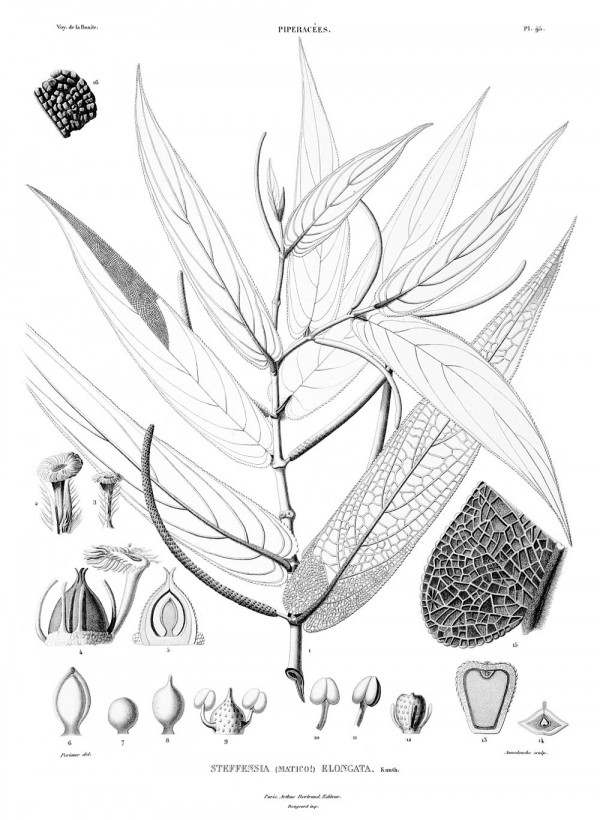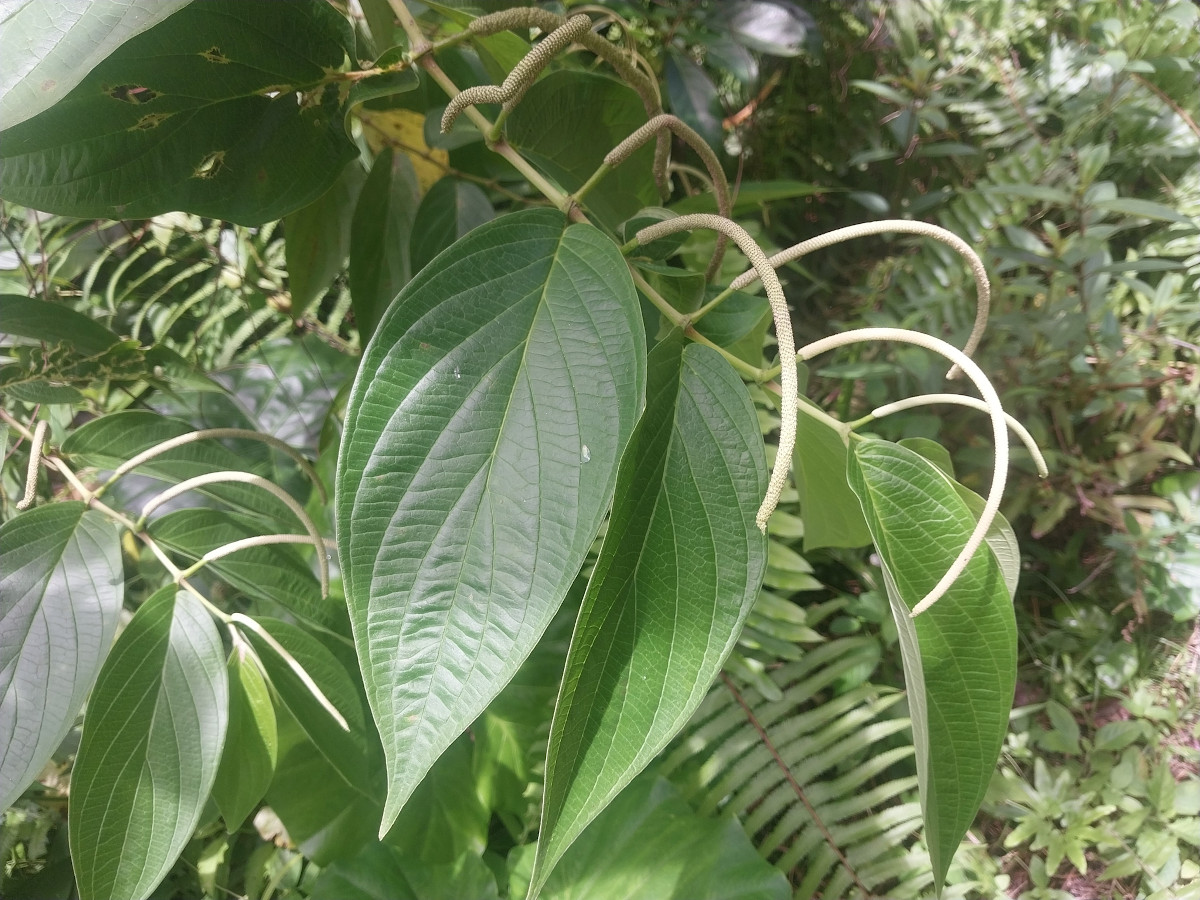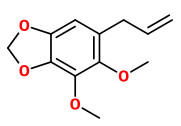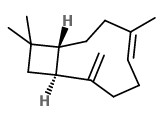Piper aduncum L. - syn.Piper angustifolium Lam.; Piper elongatum Vahl; Peperomia elongata Kunth - Piperaceae - Matico, Gebogener Pfeffer
Evergreen shrub, up to 2m high, native to the rainforests of northern South America, cultivated in South America; leaves ovate-oblong, short-petioled, abaxially soft-pubescent; inflorescences 10-20cm long.
This species has a fancy list of synonyms. http://www.tropicos.org/Name/25001128?tab=synonyms
„The essential oils of eight samples of Piper aduncum L., collected at different localities of the Amazon region, were analysed by GC–MS. The major component identified in all samples was dillapiole (31.5–97.3%). Sample A, collected at Serra do Navio (AP), showed a yield of oil and dillapiole content of 3.3% and 31.5%, respectively; sample B, collected at Melgaço (PA), 1.8% and 50.8%; sample C, collected at Benfica (PA), 1.6% and 56.3%; samples D and E, collected at Belém (PA), 1.2% and 82.2%; 1.5% and 86.9%, respectively; sample F, collected at Manaus (AM), 3.4% and 91.1%; sample G, collected at Road Manaus-Caracaraí, km 30 (AM), 3.0% and 97.3%; sample H, collected at Cruzeiro do Sul (AC), 3.2% and 88.1%. The yield of oil and dillapiole content of samples of P. aduncum occurring in Malaysia and Fiji showed 1.3% and 64.5%; and 0.5% and 58.0%, respectively. By comparison, the plants growing wild in Amazonas State had the highest oil yield and dillapiole content.“
[Constituents of the essential oil of Piper aduncum L. growing wild in the Amazon region. Maia, J. G. S., Zohhbi, M. D. G. B., Andrade, E. H. A., Santos, A. S., da Silva, M. H. L., Luz, A. I. R., Bastos, C. N., Flavour and Fragrance Journal, Vol.13(4), 1998, 269-272]
„Like many plants in the pepper family, most all parts of the Matico tree have a aromatic, spicy, peppery taste and smell. The fruits are often used as a condiment and pepper substitute. Throughout the Amazon, many of the Indian tribes use matico leaves as an antiseptic wound healer to stop bleeding, prevent infections and to speed healing. The leaves are either crushed or powdered and sprinkled directly onto the cut, wound, ulcer, and/or boil, or a tea (infusion) is made from the leaves and used as a wash. Sometimes the leaves are heated, pounded and then used as a poultice instead. The Shipibo-Conibo Indians also prepare the leaves in an infusion anduse it to treat inflammation, diarrhea, gastritis, vomiting, fever, menstrual colic, internal infections and
as a postpartum tonic.“
[Technical Data Report for Matico (Piper aduncum, angustifolium), Taylor, L., Raintree Nutrition, Inc., 2006] http://www.rain-tree.com/reports/matico-tech-report.pdf
„The volatile oil… of P. aduncum from other geographical localities have been reported. Vila and co-workers reported high sesquiterpene contents in Panama samples, with β-caryophyllene and aromadendrene being the major components, whilst Bolivian samples were composed predominantly of monoterpenes, with 1,8-cineole being the major component. In contrast, Maia and co-workers reported high dill apiole contents (31.5-97.3 %) in samples obtained from the Amazon region. Malaysian and Fijian samples were reported to contain 64.5 % and 58.0% dill apiole, respectively, while samples from Cuba recorded 82.2% composition. By far the highest reported dill apiole contents in Piper aduncum were those from the Amazonian region, as reported by Maia and co-workers, with levels of 97.3%. This observation further confirms an earlier postulation that chemical compositions can differ widely within the same species across different geographical locations.“
Volatile constituents of Piper aduncum oil grown in Papua New Guinea was mainly composed of dill apiole (43.3%), β-caryophyllene (8.2%), piperitione (6.7%) and α-humulene (5.1%).
[Volatile chemical constituents of Piper aduncum L and Piper gibbilimbum C. DC (Piperaceae) from Papua New Guinea., Rali, T., Wossa, S.W., Leach, D.N., Waterman, P.G., Molecules, 12(3), 2007, 389-394]
„The essential oils of the specimens of Piper aduncum that occur in deforested areas of Brazilian Amazon, North Brazil, are rich in dillapiole (35-90%), a derivative of phenylpropene, to which are attributed biological properties. On the other hand, the oils of the specimens with occurrence in the Atlantic Forest, and Northeastern and Southeastern Brazil, do not contain dillapiole, but only terpene compounds such as (E)-nerolidol and linalool.“
[Chemical Variation in Piper aduncum and Biological Properties of Its Dillapiole‐Rich Essential Oil., de Almeida, R.R., Souto, R.N., Bastos, C.N., da Silva, M.H., Maia, J.G., Chemistry & biodiversity, Vol.6(9), 2009, 1427-1434]
„Piper aduncum L. (Piperaceae) produces an essential oil (dillapiole) with great exploitative potential and it has proven effects against traditional cultures of phytopathogens, such as fungi, bacteria and mollusks, as well as analgesic action with low levels of toxicity… dillapiole and dihydro-dillapiole have moderate anti-phlogistic properties, indicating that they can be used as prototypes for newer anti-inflammatory compounds. Structure-activity relationship studies revealed that the benzodioxole ring is important for biological activity as well as the alkyl groups in the side chain and the methoxy groups in the aromatic ring.“
[The anti-inflammatory activity of dillapiole and some semisynthetic analogues. Parise-Filho, R., Pastrello, M., Pereira Camerlingo, C. E., Silva, G. J., Agostinho, L. A., de Souza, T., Polli, M. C., Pharmaceutical biology, Vol.49(11), 2011, 1173-1179]

Piper aduncum L. as Steffensia elongata (Vahl) Kunth
Gaudichaud-Beaupré, C., Voyage autour du monde sur la corvette la Bonite exécuté pendant les années 1836 et 1837, commandé par M. Vaillant, Atlas, t.95 (1841-1852)
http://plantgenera.org/species.php?id_species=795547

Piper aduncum, Bukit Timah, Singapore (2025) © David Torres CC BY-SA 4.0 inaturalist.org


